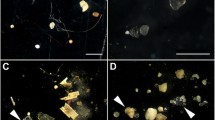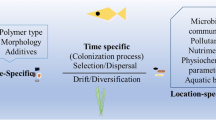Abstract
Pond mesocosms were used to assess the effects of a widely used pesticide on a natural plankton community. Atrazine, whose residuals in surface waters can occur at levels potentially hazardous to aquatic organisms, was applied at six test concentrations during a 6-week study. Structural and functional parameters were measured twice a week.
Oxygen concentration was the most sensitive parameter, with marked reductions indicating adverse affects by atrazine on photosynthesis. Taxa in the phytoplankton community showed varying sensitivity to the pollutant, although threshold concentrations for effects on most taxa were exceeded at 182 μg/L. Indirect effects due to food limitation were the most likely cause of changes in the abundance of several zooplankton species.
It is concluded that mesocosms provide realistic effects of atrazine on aquatic systems, but at the same time some difficulties with this approach are apparent when applied to seasonally dynamic planktonic systems.
Similar content being viewed by others
References
Böhm HH (1977) Sorption und Wirkung von Chlortriazin-, Phenoxy-fettsäuren- und Bipyridylium-Herbiziden in statischen und kontinuierlichen Kulturen planktischer Blau-, Kiesel- und Grünalgen. Doctoral thesis, Universität Hohenheim
Brockway DL, Smith PD, Stancil FE (1984) Fate and effects of atrazine in small aquatic microcosms. Bull Environ Contam Toxicol 32:345–353
Bundesgesetzblatt (1991) Teil I, Erste Verordnung zur Änderung der Pflanzenschutz-Anwendungsverordnung, 22 März 1991
DeNoyelles F, Kettle WD, Sinn DE (1982) The response of plankton communities in experimental ponds to atrazine, the most heavily used pesticide in the United States. Ecology 63:1285–1293
Gunkel G (1983) Untersuchungen zur ökotoxikologischen Wirkung eines Herbizids in einem aquatischen Modellökosystem I. Subletale und letale Effekte. Arch Hydrobiol/Suppl 65, 2/3:235–267
Hamala JA, Kollig HP (1985) The effects of atrazine on periphyton communities in controlled laboratory ecosystems. Chemosphere 14:1391–1408
Hamilton PB (1987) The impact of atrazine on lake periphyton communities, including carbon uptake dynamics using track autoradiography. Environ Pollut 46:83–103
Hamilton PB, Jackson GS, Kaushik NK, Solomon KR, Stephenson GL (1988) The impact of two applications of atrazine on the plankton communities of in situ enclosures. Aquatic Toxicol 13:123–140
Hoagland KD, Drenner RW, Durward J, Cross DR (1993) Freshwater community responses to mixtures of agricultural pesticides: Effects of atrazine and bifenthrin. Environ Toxicol Chem 12:627–637
Hollister TA, Walsh GE (1973) Differential responses of marine phytoplankton to herbicides: Oxygen evolution. Bull Environ Contam Toxicol 9:291–295
Huber W (1993) Ecotoxicological relevance of atrazine in aquatic systems. Environ Toxicol Chem 12:1865–1881
Jurgensen TA, Hoagland KD (1990) Effects of short-term pulses of atrazine on attached algal communities in a small stream. Arch Environ Contam Toxicol 19:617–623
Lay JP, Müller A, Peichl L, Klein W, Korte F (1984) Longterm effects of the herbicides atrazine and dichlorbenil upon the phytoplankton density and physico-chemical conditions in compartments of a freshwater pond. Chemosphere 13:821–832
Moreland DE (1980) Mechanisms of action of herbicides. Ann Rev Plant Physiol 31:597–638
Muir DCG, Yoo JY, Baker BE (1978) Residues of atrazine and N-de-ethylated atrazine in water from five agricultural watersheds in Quebec. Arch Environ Contam Toxicol 7:221–235
Neugebaur K, Zieris FJ, Huber W (1990) Ecological effects of atrazine on two outdoor artificial freshwater ecosystems. Z. Wasser-Abwasser-Forsch 23:11–17
Peichl L, Lay JP, Korte F (1984) Wirkung von Dichlorbenil und Atrazin auf die Populationsdichte von Zooplanktern in einem aquatischen Freilandsystem. Z. Wasser-Abwasser-Forsch 17:134–154
Peither A (1993) Experimente zur Ermittlung von Schadstoff-Wirkungsschwellen bei Individuen, Populationen und Planktongesellschaften in naturnahen, aquatischen Modellökosystemen. Doctoral thesis, Universität München
Schober U, Lampert W (1977) Effects of sublethal concentrations of the herbicide atrazine on growth and reproduction of Daphnia pulex. Bull Environ Contam Toxicol 17:269–277
Seitz A, Ratte HT (1991) Aquatic ecotoxicology: On the problems of extrapolation from laboratory experiments with individuals and populations to community effects in the field. Comp Biochem Physiol 100C:301–304
Weiß K, Goeppel A, Peither A, Lay JP (1992) Vergleichende Bewertung ökotoxikologischer Effekte in Labor- und Freiland-Modellsystemen (Comparison and valuation of ecotoxicological effects in laboratory and outdoor model systems). Vom Wasser 78:147–154
Wilfried D, Kluth JF, Tietjen K, Trebst A (1991) Herbizide in der Photosyntheseforschung. Angew Chemie 103:1650–1663
Author information
Authors and Affiliations
Rights and permissions
About this article
Cite this article
Jüttner, I., Peither, A., Lay, J.P. et al. An outdoor mesocosm study to assess ecotoxicological effects of atrazine on a natural plankton community. Arch. Environ. Contam. Toxicol. 29, 435–441 (1995). https://doi.org/10.1007/BF00208371
Received:
Revised:
Issue Date:
DOI: https://doi.org/10.1007/BF00208371




